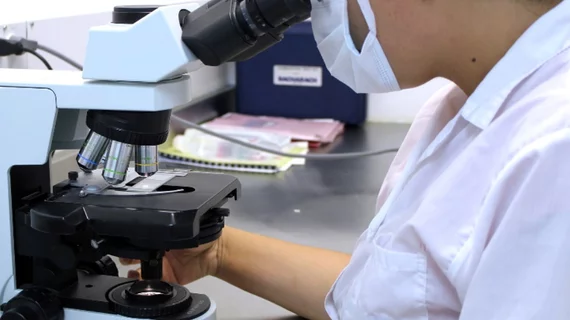AI classifies lung cancer slides with similar accuracy as pathologists
A novel deep neural network graded tumor patterns and lung adenocarcinoma subtypes on-par with a trained pathologist, reported researchers in a March 4 study published in Scientific Reports.
The team believes its algorithm could help pathologists classify the histologic pattern of lung adenocarcinoma—the most common form of the disease—and potentially lead to more accurate staging, according to the team from Dartmouth-Hitchcock Medical Center in Lebanon, New Hampshire.
For their study, the team separated 422 whole-slide images collected from Dartmouth-Hitchcock into three sets: training, development and test. The team compared their model’s classification of 143 slides to that of three pathologists.
Overall, the model achieved a kappa score of 0.525 and an agreement of 66.6 percent with the three pathologists for classifying predominant patterns. That was just higher than the 0.484 interpathologist kappa score and 62.7 percent agreement mark.
The most common disagreements in predominant subtype classification were between the acinar and lepidic subtypes. The authors noted it’s typically challenging to define an exact border between these patterns.
"Our study demonstrates that machine learning can achieve high performance on a challenging image classification task and has the potential to be an asset to lung cancer management," said Saeed Hassanpour, PhD, of Dartmouth College, and colleagues. "Clinical implementation of our system would be able to assist pathologists for accurate classification of lung cancer subtypes, which is critical for prognosis and treatment."
As in many AI platforms, the current digital pathology method was only tested on data from a single institution, a clear limitation of the study. Previous research, including a Nov 2018 study published in PLOS Medicine, found algorithms trained to detect pneumonia on chest x-rays performed poorly when tested on data from another health system.
The team explained that more work can be done in the future to expand the reaches of their model, including drawing bounding boxes around cancerous regions using an AI approach. While this would necessitate a larger annotated dataset and more man hours it would help pathologists identify exact cellular structures the approach identified as cancerous, according to the researchers.
“The application of our model in a clinical setting, which our research team will pursue as a next step, is essentially an automated platform for quality assurance in reading histologic slides of lung adenocarcinoma,” the researchers added. “A successful implementation of this system will support more accurate classification of lung cancer grade and ultimately facilitate the entire process of lung cancer diagnosis.”

